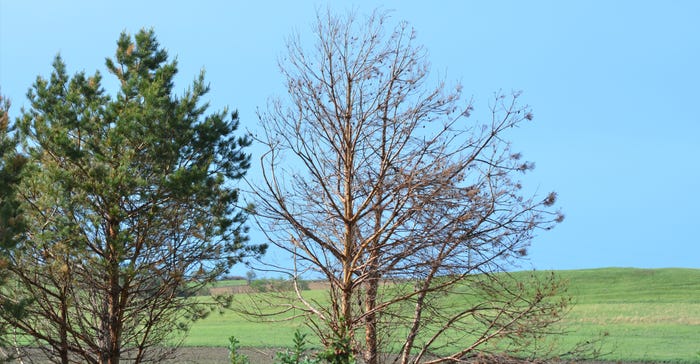
Over the years, now-retired Nebraska Forest Service District forester Steve Rasmussen has shared his expertise in the field and forest on all kinds of rural forestry issues.
In his retirement, Rasmussen lives and works on his farm near Plainview, Neb. He and his family have operated a choose-and-cut Christmas tree farm for many years, but Scotch pine trees planted 30 years ago that did not sell have now succumbed to pine wilt as they have aged.
What do you do with 30-foot-tall dead trees besides cutting them down and pushing them into a pile to be burned? It seems a shame to see that pine wood go up in smoke.
Another way
Rasmussen has a way and use to handle those dying trees. He logged them. “We have Scotch pines that we had planted for Christmas trees, did not sell, and had died from pine wilt,” Rasmussen says. “So, I harvested a 12-inch diameter tree and logged it into my sawmill.”
He milled the log up and got some blue-stain and knotty pine to work with for his project.
“I utilized this homegrown lumber for a barn door in my new garage,” Rasmussen says. “The carbon in the boards is now tied up and not released. I also used some of the residue and branches for firewood starter sticks in our wood stove, and finally, created wildlife habitat with brush piles from the top of the cut tree.”
Pine wilt is caused by the pinewood nematode, a microscopic worm that is moved from infested to noninfested pine trees by the pine sawyer beetle. Pine wilt is especially fatal to Scotch pines and can kill trees in a few weeks or a few months after the beetle introduces the nematode to the tree during the early summer. The needles initially turn grayish-green, then tan and finally brown.
At first, often there may only be a few infected branches, but the issue soon spreads to the remaining branches. In other situations, the entire tree can turn brown all at once. It attacks primarily Scotch pine and does not strike other types of pines or evergreens to the same extent.
Lumber from infected trees, as suggested by Rasmussen, has sectors of cobalt-blue discoloration, caused by blue-stain fungi. The blue stain does not affect the structural integrity of the lumber and is more cosmetic.
This coloration can be quite desirable for woodworkers and others who enjoy finding new ways to use this lumber in what Rasmussen fondly refers to as “full circle forestry” on his family farm.
Small mills
“With the increased popularity of the small bandsaw mills across the country, there is probably a sawmill that can cut your logs close to where you live,” Rasmussen says. “Besides Scotch pines, there are nice hardwood trees like black walnut, green ash, hackberry, mulberry, and elm in many old windbreaks that are removed or renovated.”
Rasmussen promotes using those trees being removed by milling them for lumber use rather than the “pile and burn” approach. Get a list of sawmills that can mill trees in Nebraska at nfs.unl.edu, or contact your state forestry service for a list in your own region.
About the Author(s)
You May Also Like






